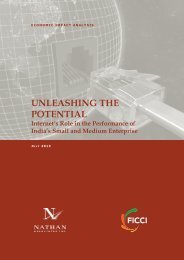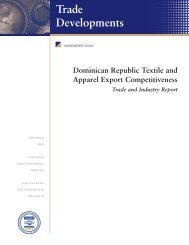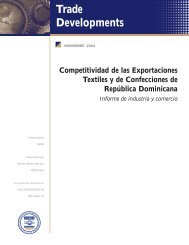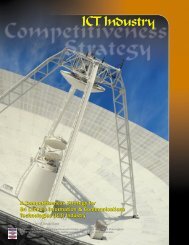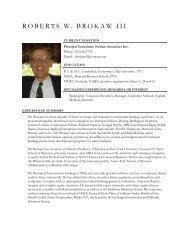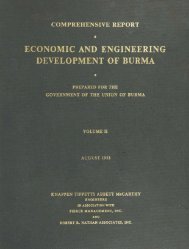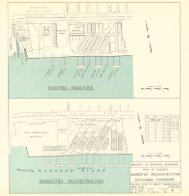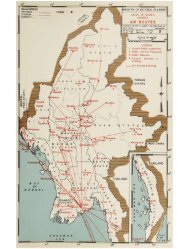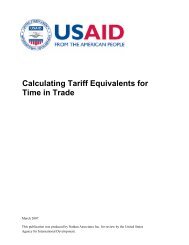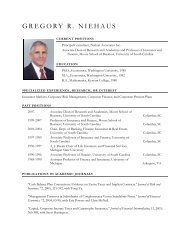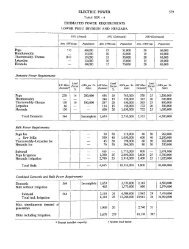Putting it to Work in Developing Countries - Nathan Associates
Putting it to Work in Developing Countries - Nathan Associates
Putting it to Work in Developing Countries - Nathan Associates
You also want an ePaper? Increase the reach of your titles
YUMPU automatically turns print PDFs into web optimized ePapers that Google loves.
and domestic <strong>in</strong>ves<strong>to</strong>rs is particularly important,<br />
as is loosen<strong>in</strong>g the regulations <strong>in</strong> FDI<br />
regimes.<br />
Taken <strong>to</strong>gether, these fac<strong>to</strong>rs create the compet<strong>it</strong>ive<br />
markets that give firms <strong>in</strong>centives and signals<br />
<strong>to</strong> perform efficiently.<br />
F<strong>in</strong>ally, reliable, cost-effective <strong>in</strong>frastructure is<br />
cr<strong>it</strong>ical <strong>to</strong> a favorable <strong>in</strong>vestment climate.<br />
Foreign <strong>in</strong>ves<strong>to</strong>rs repeatedly identify physical<br />
<strong>in</strong>frastructure—power, transport, water—as the<br />
most important determ<strong>in</strong>ant of a decision <strong>to</strong><br />
<strong>in</strong>vest, w<strong>it</strong>h cost of util<strong>it</strong>ies runn<strong>in</strong>g a close second.<br />
10 For example, <strong>in</strong> a recent analysis of FDI<br />
impacts <strong>in</strong> 14 manufactur<strong>in</strong>g and services <strong>in</strong>dustries<br />
<strong>in</strong> Brazil, Ch<strong>in</strong>a, India, and Mexico, mult<strong>in</strong>ational<br />
executives rated “high qual<strong>it</strong>y <strong>in</strong>frastructure”<br />
as the fac<strong>to</strong>r most affect<strong>in</strong>g their<br />
choice of offshore location, ahead of availabil<strong>it</strong>y<br />
of tra<strong>in</strong>ed workers, the regula<strong>to</strong>ry environment,<br />
and other variables. 11 Technological <strong>in</strong>frastructure,<br />
especially <strong>in</strong>formation and communications<br />
technology, is also a determ<strong>in</strong>ant. 12<br />
Moreover, widespread basic education and public<br />
health systems, both essential <strong>to</strong> workforce<br />
development and health, are fundamental <strong>to</strong> a<br />
good <strong>in</strong>vestment climate. 13 Together, these elements<br />
create a “virtuous circle” <strong>in</strong> which<br />
improvements <strong>in</strong> <strong>in</strong>frastructure lead <strong>to</strong> efficiencies<br />
that attract <strong>in</strong>vestment, thus expand<strong>in</strong>g the<br />
service base that makes <strong>in</strong>frastructure even more<br />
cost-effective for bus<strong>in</strong>ess.<br />
ASSESSING THE CLIMATE<br />
Governments seek<strong>in</strong>g <strong>to</strong> attract FDI can beg<strong>in</strong><br />
improv<strong>in</strong>g the <strong>in</strong>vestment climate by assess<strong>in</strong>g<br />
cond<strong>it</strong>ions. A number of <strong>to</strong>ols are available for<br />
the purpose, beg<strong>in</strong>n<strong>in</strong>g w<strong>it</strong>h the Policy<br />
Bus<strong>in</strong>ess Environment and FDI: Boom or Backlash<br />
A recent forecast of worldwide and emerg- used by companies <strong>to</strong> formulate their global<br />
<strong>in</strong>g market FDI flows highlights the impor- bus<strong>in</strong>ess strategies.” After runn<strong>in</strong>g <strong>it</strong>s model<br />
tance of the “bus<strong>in</strong>ess environment” as a <strong>to</strong> project FDI flows, EIU noted that <strong>it</strong>s<br />
determ<strong>in</strong>ant of FDI activ<strong>it</strong>y. Draw<strong>in</strong>g on results were particularly sens<strong>it</strong>ive <strong>to</strong> variadata<br />
from 82 economies, the Economist tions <strong>in</strong> the bus<strong>in</strong>ess environment. This<br />
Intelligence Un<strong>it</strong> (EIU) prepared a medi- variable was then used <strong>to</strong> construct alternaum-term<br />
forecast (2006-2010) of FDI for tive FDI “boom” and “backlash” scenarios<br />
developed economies and emerg<strong>in</strong>g mar- around the basel<strong>in</strong>e forecast. The boom scekets.<br />
In the EIU’s forecast<strong>in</strong>g model, FDI nario, which assumes that all countries’<br />
flows are related <strong>to</strong> a number of variables: qual<strong>it</strong>y of bus<strong>in</strong>ess environment scores are<br />
market size, GDP growth, natural resource 10 percent higher than the values actually<br />
endowments, distance between countries, forecast, produces a 45 percent <strong>in</strong>crease <strong>in</strong><br />
labor costs, and the bus<strong>in</strong>ess environment. FDI flows for emerg<strong>in</strong>g markets. In the<br />
The latter is an <strong>in</strong>dex of values of 91 <strong>in</strong>dica- backlash scenario, values for an array of<br />
<strong>to</strong>rs organized <strong>in</strong><strong>to</strong> 10 categories represent- bus<strong>in</strong>ess environment <strong>in</strong>dica<strong>to</strong>rs are lowered<br />
<strong>in</strong>g various aspects of the “policy, <strong>in</strong>st<strong>it</strong>u- <strong>to</strong> represent more restrictive FDI polices<br />
tional and operat<strong>in</strong>g environment.” It is and ris<strong>in</strong>g protectionism. The result A 19<br />
designed <strong>to</strong> represent the “ma<strong>in</strong> cr<strong>it</strong>eria percent drop <strong>in</strong> FDI <strong>in</strong> emerg<strong>in</strong>g markets.<br />
SOURCE: EIU, World Investment Prospects <strong>to</strong> 2010: Boom or Backlash (New York: EIU,<br />
2006) p. 44 and 63.<br />
57



